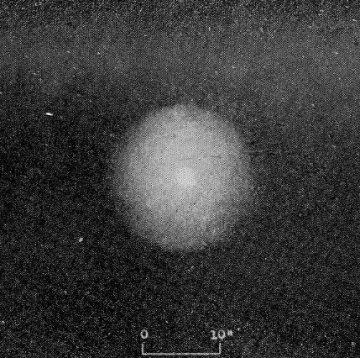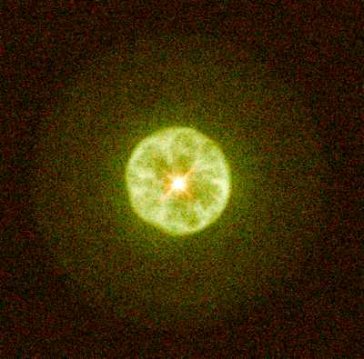IC 3568
THE LEMON SLICE NEBULA
"The nucleus is surrounded by very bright matter in disk 18" in
diameter, apparently perfectly round, and fading out a little at
the edges. Very bright..." (Curtis). On the periphery of the
modern constellation Camelopardalis, it
has the distinction of being the most northerly of the classic
planetaries, just 7.5 degrees south of Polaris, more or less between it and the
bowl of the Little Dipper.
Many planetary nebulae show bi-polar, twin-lobed, structures, or
are obvious double ring affairs. Look for example at NGC 7009 or NGC
7662, or at most of the others on the list. But, as seen in
Curtis's composite drawing on the left, IC 3568 just stares blandly
back at you with no visually detectable structure, the only variant
a 12th magnitude (12.3) central star. Lawrence Aller referred to
it as "the theoretician's planetary," as it seemed so perfect, and
therefore perhaps more understandable than most.
The Hubble image on the right, however, reveals subtle detail that
the eye cannot easily see, a radial pattern that gives the nebula
the name "The Lemon Slice Nebula," which is reinforced through
false color. Brightening at the edges, the Lemon Slice looks more
like a shell, the whole lemon as it were. The star, with a
temperature estimated from two methods at 57,000 Kelvin and still
heating (at a luminosity a couple thousand times that of the Sun),
has recently made the transition to becoming hot enough to
marginally doubly-ionize the nebula's helium.
The distance, as usual, is uncertain, the best estimate probably
around 4500 light years, which gives IC 3568 a physical diameter of
not quite half a light year. Deep imagery reveals an inner shell
about half the size. Growing at the rate of some dozen kilometers
per second, the nebula rather seems like a grown-up version of IC 418.
Left: Image by H. D. Curtis from Publications of the Lick
Observatory, Volume 13, Part III, 1918. Right: Howard Bond
(STScI), Robin Ciardullo (Penn. State U.), and NASA/ESA.



